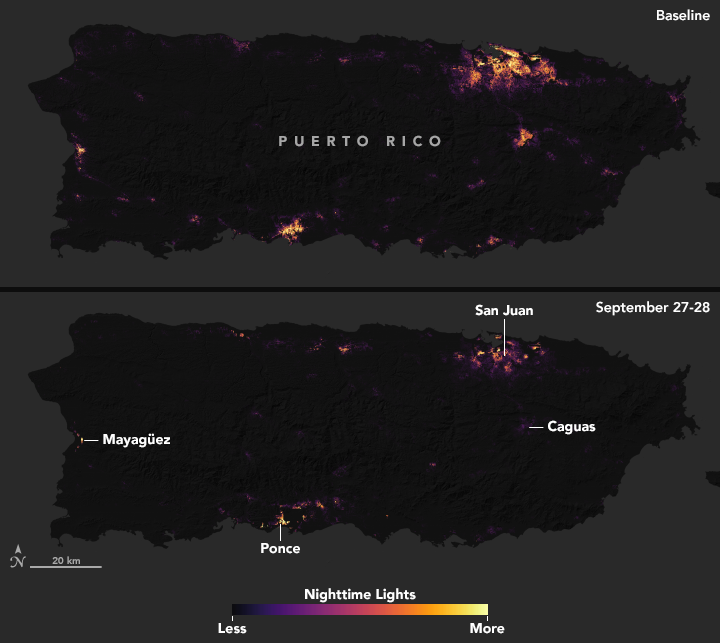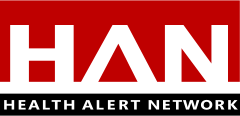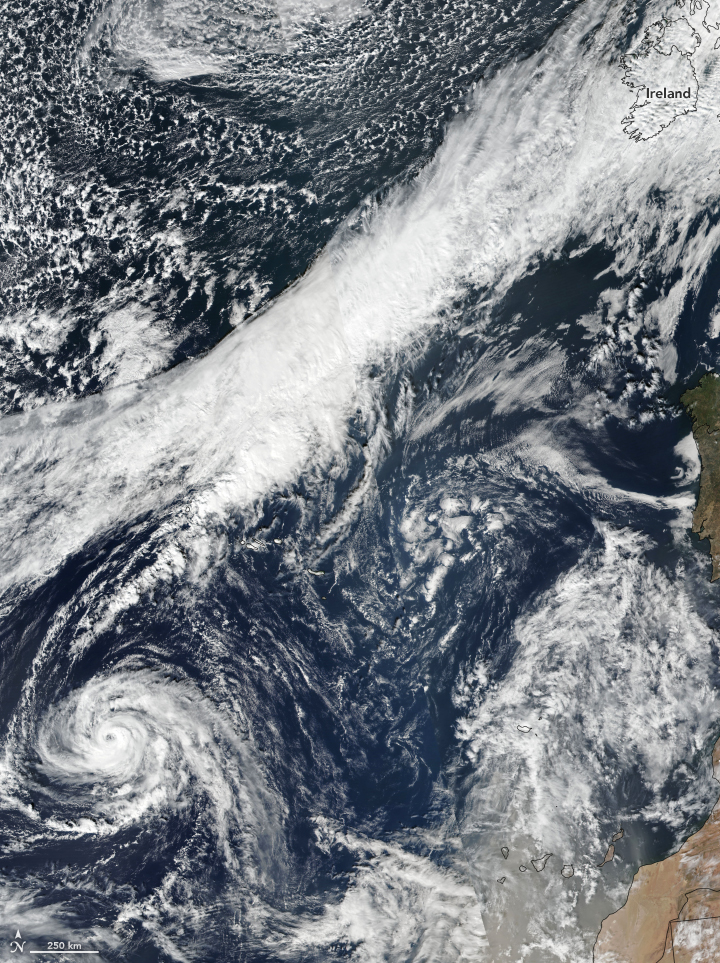Archive for the ‘Tropical storms’ Category
Puerto Rico: Official Death Toll: 62. Actual Deaths May Be 1,052.
Saturday, December 9th, 2017“…..The Times’s analysis found that in the 42 days after Hurricane Maria made landfall on Sept. 20 as a Category 4 storm, 1,052 more people than usual died across the island. The analysis compared the number of deaths for each day in 2017 with the average of the number of deaths for the same days in 2015 and 2016.…..”
Philippe
Sunday, October 29th, 2017
000
WTNT33 KNHC 290240
TCPAT3
BULLETIN
Tropical Storm Philippe Advisory Number 6
NWS National Hurricane Center Miami FL AL182017
1100 PM EDT Sat Oct 28 2017
…CENTER OF POORLY ORGANIZED PHILIPPE APPROACHING THE FLORIDA
KEYS…
…HEAVY RAINS OCCURRING OVER FROM CENTRAL CUBA ACROSS SOUTHERN
FLORIDA TO THE NORTHWESTERN BAHAMAS…
SUMMARY OF 1100 PM EDT…0300 UTC…INFORMATION
———————————————–
LOCATION…24.8N 82.1W
ABOUT 25 MI…40 KM NW OF KEY WEST FLORIDA
MAXIMUM SUSTAINED WINDS…40 MPH…65 KM/H
PRESENT MOVEMENT…NNE OR 15 DEGREES AT 24 MPH…39 KM/H
MINIMUM CENTRAL PRESSURE…1003 MB…29.62 INCHES
WATCHES AND WARNINGS
——————–
CHANGES WITH THIS ADVISORY:
None.
SUMMARY OF WATCHES AND WARNINGS IN EFFECT:
A Tropical Storm Warning is in effect for…
* Cuban provinces of Isla de la Juventud, La Habana, Ciudad de la
Habana, Matanzas, Cienfuegos, and Villa Clara
* Northwestern Bahamas
A Tropical Storm Watch is in effect for…
* Craig Key to Golden Beach
* Central Bahamas
A Tropical Storm Warning means that tropical storm conditions are
expected somewhere within the warning area, in this case within the
next 12-18 hours.
A Tropical Storm Watch means that tropical storm conditions are
possible within the watch area, in this case within 24 hours.
For storm information specific to your area in the United States,
including possible inland watches and warnings, please monitor
products issued by your local National Weather Service forecast
office. For storm information specific to your area outside the
United States, please monitor products issued by your national
meteorological service.
DISCUSSION AND 48-HOUR OUTLOOK
——————————
At 1100 PM EDT (0300 UTC), the center of Tropical Storm Philippe was
located near latitude 24.8 North, longitude 82.1 West. Philippe is
moving toward the north-northeast near 24 mph (39 km/h). A turn
toward the northeast is expected during the next few hours, and a
rapid motion toward the northeast is expected Sunday through
Monday. On the forecast track, the center of Philippe will move
across the Florida Keys or the southern tip of the Florida peninsula
overnight, and across the northwestern Bahamas Sunday morning.
Maximum sustained winds are near 40 mph (65 km/h) with higher gusts.
Some strengthening is forecast during the next 48 hours. However,
Philippe is expected to become a post-tropical cyclone on Monday.
Tropical-storm-force winds extend outward up to 105 miles (165 km)
mainly to the east and southeast of the center.
The estimated minimum central pressure is 1003 mb (29.62 inches).
HAZARDS AFFECTING LAND
———————-
RAINFALL: Across the northern Bahamas and south Florida including
the Keys rainfall amounts of 3 to 5 inches with isolated maximum
totals of 8 inches are expected through Sunday. These rainfall
totals may produce flash flooding, especially in urbanized areas.
Additional rainfall amounts of 1 to 2 inches are possible across
portions of western and central Cuba, which may lead to life-
threatening flash floods and mudslides in the higher terrain.
WIND: Tropical storm conditions are likely occurring in the
warning area across Cuba. Tropical storm conditions are expected to
occur in the warning area later tonight across the northwestern
Bahamas. Tropical storm conditions are possible across the upper
Florida Keys and southeast Florida overnight, and in the central
Bahamas by Sunday morning.
TORNADOES: An isolated tornado or two is possible across far South
Florida and the Florida Keys tonight.
NEXT ADVISORY
————-
Next intermediate advisory at 200 AM EDT.
Next complete advisory at 500 AM EDT.
$$
Forecaster Beven
CDC recommendations to healthcare providers treating patients in Puerto Rico and USVI, as well as those treating patients in the continental US who recently traveled in hurricane-affected areas during the period of September 2017 – March 2018.
Wednesday, October 25th, 2017Advice for Providers Treating Patients in or Recently Returned from Hurricane-Affected Areas, Including Puerto Rico and US Virgin Islands
Distributed via the CDC Health Alert Network
October 24, 2017, 1330 ET (1:30 PM ET)
CDCHAN-00408
Summary
The Centers for Disease Control and Prevention (CDC) is working with federal, state, territorial, and local agencies and global health partners in response to recent hurricanes. CDC is aware of media reports and anecdotal accounts of various infectious diseases in hurricane-affected areas, including Puerto Rico and the US Virgin Islands (USVI). Because of compromised drinking water and decreased access to safe water, food, and shelter, the conditions for outbreaks of infectious diseases exist.
The purpose of this HAN advisory is to remind clinicians assessing patients currently in or recently returned from hurricane-affected areas to be vigilant in looking for certain infectious diseases, including leptospirosis, dengue, hepatitis A, typhoid fever, vibriosis, and influenza. Additionally, this Advisory provides guidance to state and territorial health departments on enhanced disease reporting.
Background
Hurricanes Irma and Maria made landfall in Puerto Rico and USVI in September 2017, causing widespread flooding and devastation. Natural hazards associated with the storms continue to affect many areas. Infectious disease outbreaks of diarrheal and respiratory illnesses can occur when access to safe water and sewage systems are disrupted and personal hygiene is difficult to maintain. Additionally, vector borne diseases can occur due to increased mosquito breeding in standing water; both Puerto Rico and USVI are at risk for outbreaks of dengue, Zika, and chikungunya.
Health care providers and public health practitioners should be aware that post-hurricane environmental conditions may pose an increased risk for the spread of infectious diseases among patients in or recently returned from hurricane-affected areas; including leptospirosis, dengue, hepatitis A, typhoid fever, vibriosis, and influenza. The period of heightened risk may last through March 2018, based on current predictions of full restoration of power and safe water systems in Puerto Rico and USVI.
In addition, providers in health care facilities that have experienced water damage or contaminated water systems should be aware of the potential for increased risk of infections in those facilities due to invasive fungi, nontuberculous Mycobacterium species, Legionella species, and other Gram-negative bacteria associated with water (e.g., Pseudomonas), especially among critically ill or immunocompromised patients.
Cholera has not occurred in Puerto Rico or USVI in many decades and is not expected to occur post-hurricane.
Recommendations
These recommendations apply to healthcare providers treating patients in Puerto Rico and USVI, as well as those treating patients in the continental US who recently traveled in hurricane-affected areas (e.g., within the past 4 weeks), during the period of September 2017 – March 2018.
- Health care providers and public health practitioners in hurricane-affected areas should look for community and healthcare-associated infectious diseases.
- Health care providers in the continental US are encouraged to ask patients about recent travel (e.g., within the past 4 weeks) to hurricane-affected areas.
- All healthcare providers should consider less common infectious disease etiologies in patients presenting with evidence of acute respiratory illness, gastroenteritis, renal or hepatic failure, wound infection, or other febrile illness. Some particularly important infectious diseases to consider include leptospirosis, dengue, hepatitis A, typhoid fever, vibriosis, and influenza.
- In the context of limited laboratory resources in hurricane-affected areas, health care providers should contact their territorial or state health department if they need assistance with ordering specific diagnostic tests.
- For certain conditions, such as leptospirosis, empiric therapy should be considered pending results of diagnostic tests— treatment for leptospirosis is most effective when initiated early in the disease process. Providers can contact their territorial or state health department or CDC for consultation.
- Local health care providers are strongly encouraged to report patients for whom there is a high level of suspicion for leptospirosis, dengue, hepatitis A, typhoid, and vibriosis to their local health authorities, while awaiting laboratory confirmation.
- Confirmed cases of leptospirosis, dengue, hepatitis A, typhoid fever, and vibriosis should be immediately reported to the territorial or state health department to facilitate public health investigation and, as appropriate, mitigate the risk of local transmission. While some of these conditions are not listed as reportable conditions in all states, they are conditions of public health importance and should be reported.
For More Information
- General health information about hurricanes and other tropical storms: https://www.cdc.gov/disasters/hurricanes/index.html
- Information about Hurricane Maria: https://www.cdc.gov/disasters/hurricanes/hurricane_maria.html
- Information for Travelers:
- Travel notice for Hurricanes Irma and Maria in the Caribbean: https://wwwnc.cdc.gov/travel/notices/alert/hurricane-irma-in-the-caribbean
- Health advice for travelers to Puerto Rico: https://wwwnc.cdc.gov/travel/destinations/traveler/none/puerto-rico?s_cid=ncezid-dgmq-travel-single-001
- Health advice for travelers to the U.S. Virgin Islands: https://wwwnc.cdc.gov/travel/destinations/traveler/none/usvirgin-islands?s_cid=ncezid-dgmq-travel-leftnav-traveler
- Resources from CDC Health Information for International Travel 2018 (the Yellow Book):
- Post-travel Evaluation: https://wwwnc.cdc.gov/travel/yellowbook/2018/post-travel-evaluation/general-approach-to-the-returned-traveler
- Information about infectious diseases after a disaster: https://www.cdc.gov/disasters/disease/infectious.html
- Dengue: https://www.cdc.gov/dengue/index.html
- Hepatitis A: https://www.cdc.gov/hepatitis/HAV/index.htm
- Leptospirosis: https://www.cdc.gov/leptospirosis/
- Typhoid fever: https://www.cdc.gov/typhoid-fever/index.html
- Vibriosis: https://www.cdc.gov/vibrio/index.html
- Information about other infectious diseases of concern:
- Conjunctivitis: https://www.cdc.gov/conjunctivitis/
- Influenza: https://www.cdc.gov/flu/index.htm
- Scabies: https://www.cdc.gov/parasites/scabies/index.html
- Tetanus and wound management: https://www.cdc.gov/disasters/emergwoundhcp.html
- Tetanus in Areas Affected by a Hurricane: Guidelines for Clinicians https://emergency.cdc.gov/coca/cocanow/2017/2017sept12.asp
Today’s FEMA SitRep on Puerto Rico and USVI after the hurricanes
Sunday, October 22nd, 2017Puerto Rico
Puerto Rico: The USNS Comfort, a 70,000-metric-ton ship staffed with roughly 800 medical and support personnel and 250 beds, has treated only about 150 people since it arrived on Oct. 3
Friday, October 20th, 2017- “….Hurricane Maria, a Category 4 storm, slammed into the U.S. Commonwealth of 3.4 million people on Sept. 20 with sustained winds of 155 miles an hour, killing nearly 50 residents and leaving 250,000 without homes…..”
- “….Patients who show up at the Comfort aren’t turned away. But the normal path is through San Juan’s Centro Medico hospital, where doctors evaluate requests for transfer from other hospitals, contact a medical-operation center which in turn dials the ship. Patients are flown to the vessel via helicopter from other hospitals. …”

- “……officials recently changed the protocol to allow regional hospitals to contact the operation center directly….”
- “….The DoD…stationed personnel outside of hospitals around the island with satellite phones to relay information about hospitals’ power, water and patient count, in case there was need to evacuate or transfer patients…..”
- “…..Four U.S. Army crews were recently certified to land on the ship during daytime…”
- “…..Ryder Memorial Hospital….The Oct. 4 power failure prompted the evacuation of 29 patients by helicopter to San Juan, where five were transferred to the Comfort…..”
- “….Two days later, the Comfort took in four patients after generators failed at Hospital Menonita in Caguas….”
- “….As it has moved along Puerto Rico’s north coast, the ship has also supplied hospitals with more than 10 tons of food and water, plus 29,100 liters of oxygen…….”
Fanned by Ophelia, at least 35 people have been killed and dozens more injured by wildfires in Portugal and northern Spain
Tuesday, October 17th, 2017Audio: 911 Calls from the Rehabilitation Center after Hurricane Irma
Tuesday, October 17th, 2017Puerto Rico and U.S. Virgin Islands Need Urgent Aid Now to Avert Public Health Crises
Friday, October 13th, 2017“…..Infectious disease risks in the wake of these hurricanes include exposures to waterborne pathogens, the spread of infections in crowded shelters, food-borne illnesses, mosquito-borne infections and mold-related illnesses. Reliable access to medicines for patients with HIV and tuberculosis is also critical to preventing treatment disruptions that increase patients’ risks of serious illness, disease progression, and to avoid the emergence of drug-resistance or transmission of these infections. Health workers in the affected areas struggle with shortages of antibiotics and hydration solutions, and they are bracing for potential infectious disease outbreaks. Ensuring that basic needs are met including access to clean water, safe food and sanitation as essential for infection control. …..”

The images above show lighting around San Juan, capital of the commonwealth; the images below show the entire island. One image in each pair shows a typical night before Maria made landfall, based upon cloud-free and low moonlight conditions; the second image is a composite that shows light detected by VIIRS on the nights of September 27 and 28, 2017. By compositing two nights, the image has fewer clouds blocking the view. (Note: some clouds still blocked light emissions during the two nights, especially across southeastern and western Puerto Rico.) The images above show widespread outages around San Juan, including key hospital and transportation infrastructure.

FEMA SitRep for Puerto Rico and USVI: 10/12/17
Thursday, October 12th, 2017Hurricane Update – Caribbean Current Situation Life safety and life sustainment efforts in PR and USVI ongoing.
Passing showers possible for eastern PR and USVI.
Flash Flood Watch remains in effect for PR through this evening.
Impacts Population: • Shelters: 107 (-1) open with 5,602 (-140) occupants in PR; 5 open with 339 occupants in USVI •
Disaster Assistance Registrations: 370k in PR; 9k in USVI
Communications: • PR: 22% of cell towers operational; 64% of the Puerto Rico population live in areas where wireless coverage is available for voice and text messages • USVI: 45% of cell towers operational (St. Thomas: 50%; St. John: no cell sites operational; St. Croix: 48%); St. John being serviced by temporary Wi-Fi hot spots and personal MiFi devices
Power: • Restoration: PR: 10.6% have electricity; PREPA is reporting that the failure of tie line that caused the generation plant to go down October 10 has been repaired; USVI: 14.4% St. Thomas; 0% St. John; 12% St. Croix on power grid; 90% of the USVI to be restored by late December
Generators: PR: 70 installed; 135 available; 365 en route; USVI: 55 generators installed, 50 available; 39 en route
Health and Medical: • PR: 65 out of 67 hospitals open; 36 hospitals connected to power grid, 29 on generator power; USNS Comfort is en route to Arecibo and is subsequently scheduled to move to Aguadilla • USVI: USVI Department of Health (DOH) is without power; public health clinic co-located at the DOH is closed and vaccine supply located at the facility affected; ESF-8 working with DOH to assess damage to vaccine supply. St. Croix: Charles Harwood Hospital and Governor Juan Luis Hospital damaged; partially open; St. Thomas: Schneider Medical Center damaged; established mobile medical facility
FEMA Response • NRCC: Level I (day shift), Enhanced Watch (night shift) • National IMAT East-2: Deployed to PR • FEMA Region II & X IMATs: Deployed to USVI • FEMA Region III IMAT: Deployed to PR • MERS teams deployed to both USVI & PR





